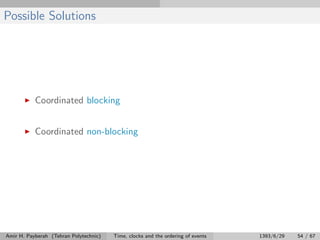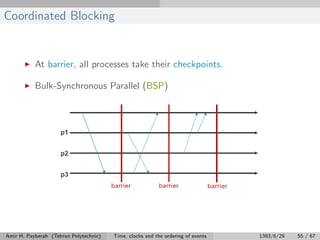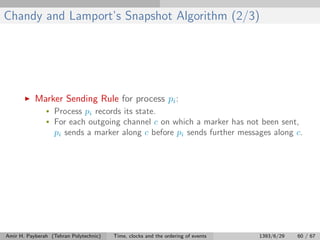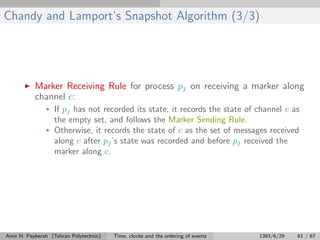The document discusses modeling distributed systems. It defines a distributed system as a set of nodes connected by a network that appear as a single system to users. It describes modeling nodes as state machines that can send/receive messages and do computations. The document also discusses modeling message passing between nodes and the network connecting them.














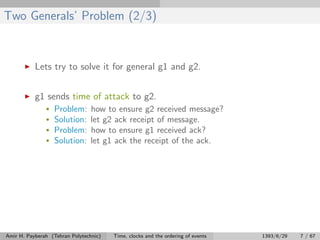











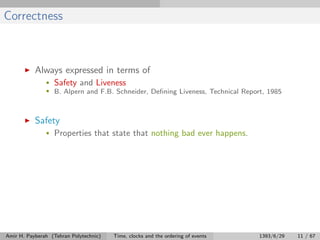























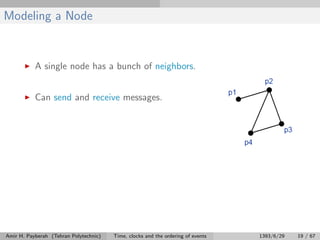





































![Vector Clocks
At each process, maintain a clock for every other process.
• Each clock Vi is a vector of size N.
• Vi[j] contains process pis knowledge about process pj’s clock.
• Initially, Vi[j] := 0 for i, j ∈ {1, · · · , N}.
Amir H. Payberah (Tehran Polytechnic) Time, clocks and the ordering of events 1393/6/29 42 / 67](https://image.slidesharecdn.com/time-150126075137-conversion-gate02/85/Time-clocks-and-the-ordering-of-events-89-320.jpg)
![Vector Clocks
At each process, maintain a clock for every other process.
• Each clock Vi is a vector of size N.
• Vi[j] contains process pis knowledge about process pj’s clock.
• Initially, Vi[j] := 0 for i, j ∈ {1, · · · , N}.
Before pi timestamps an event: Vi[i] := Vi[i] + 1.
Amir H. Payberah (Tehran Polytechnic) Time, clocks and the ordering of events 1393/6/29 42 / 67](https://image.slidesharecdn.com/time-150126075137-conversion-gate02/85/Time-clocks-and-the-ordering-of-events-90-320.jpg)
![Vector Clocks
At each process, maintain a clock for every other process.
• Each clock Vi is a vector of size N.
• Vi[j] contains process pis knowledge about process pj’s clock.
• Initially, Vi[j] := 0 for i, j ∈ {1, · · · , N}.
Before pi timestamps an event: Vi[i] := Vi[i] + 1.
Whenever a message m is sent from pi to pj:
• pi executes Vi[i] := Vi[i] + 1 and sends Vi with m.
• pj receives Vi with m and merges the vector clocks Vi and Vj:
Vj[k] =
max(Vj[k], Vi[k]) + 1 if j = k
max(Vj[k], Vi[k]) otherwise
Amir H. Payberah (Tehran Polytechnic) Time, clocks and the ordering of events 1393/6/29 42 / 67](https://image.slidesharecdn.com/time-150126075137-conversion-gate02/85/Time-clocks-and-the-ordering-of-events-91-320.jpg)

![Comparing Vector Clocks
V = V iff V [i] = V [i] for i ∈ {1, · · · , N}
V ≤ V iff V [i] ≤ V [i] for i ∈ {1, · · · , N}
V ||V iff V ≤ V ∧ V ≤ V
Amir H. Payberah (Tehran Polytechnic) Time, clocks and the ordering of events 1393/6/29 44 / 67](https://image.slidesharecdn.com/time-150126075137-conversion-gate02/85/Time-clocks-and-the-ordering-of-events-93-320.jpg)




















